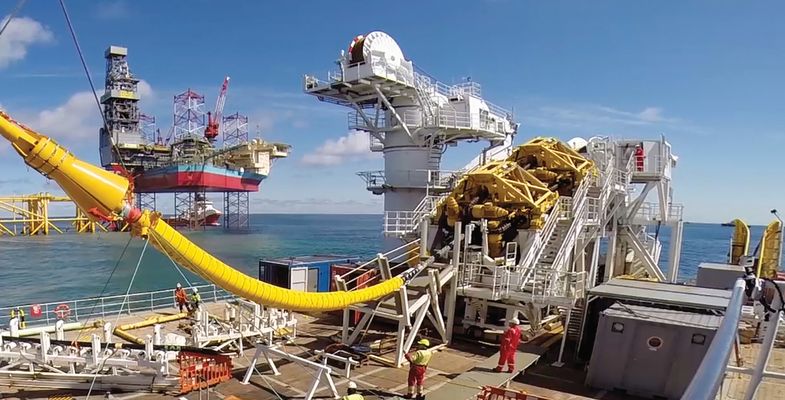IEC 60228 Conductor Resistance Testing for Subsea Cables
The IEC 60228 standard is a cornerstone in ensuring that submarine cables are fit for purpose, especially given the harsh marine environment. This standard provides detailed specifications and requirements for conductor resistance testing of subsea power cables used in offshore platforms and underwater applications.
Conductor resistance tests are critical for verifying the integrity and reliability of the electrical conductors within a cable. These tests help ensure that the cables can withstand the challenges posed by their environment, including mechanical stress from waves, saltwater corrosion, and temperature variations. The test parameters must be meticulously followed to guarantee accurate results.
During testing, several steps are involved in preparing the specimen for measurement of conductor resistance:
- Selection of appropriate measuring equipment that meets the specified accuracy requirements as per IEC standards.
- Precise preparation and conditioning of the cable sample to ensure it is free from any foreign materials or contaminants.
- Setting up the test environment to replicate real-world conditions, including temperature control.
The testing process itself involves:
- Measuring the resistance of each individual conductor within the cable.
- Comparing these measurements against the manufacturer’s specifications and IEC standards.
- Recording all data points for future reference and comparison with results from previous tests.
The outcome of this testing is crucial for several reasons:
- Mechanical Integrity: Ensures that the cable will not fail under normal operating conditions, which is essential in offshore platforms where downtime can be extremely costly.
- Electrical Performance: Guarantees consistent electrical performance throughout its operational life. This prevents issues like short circuits or excessive power loss during transmission.
- Safety Compliance: Adherence to international standards ensures that the cable meets all necessary safety regulations, thereby protecting personnel and equipment from potential hazards.
The importance of this testing cannot be overstated, especially in sectors like renewable energy where offshore wind farms are rapidly expanding. Subsea cables serve as lifelines for these installations, providing stable power transmission to shore-based facilities. By ensuring the reliability of these cables through rigorous IEC 60228 conductor resistance tests, we contribute significantly to the success and longevity of such projects.
For R&D engineers, this testing is not just a compliance requirement but also an opportunity to innovate and improve cable designs. By understanding the precise resistance values under various conditions, they can identify areas for enhancement in future iterations. This knowledge translates directly into better-performing cables that are more resilient against environmental factors.
The IEC 60228 standard is widely recognized globally due to its stringent requirements and consistent application across different regions. Compliance with this standard ensures seamless integration of subsea cables into existing infrastructure, fostering international collaboration in the renewable energy sector.
Applied Standards
The IEC 60228 series includes several standards that collectively provide a comprehensive framework for conductor resistance testing. These include:
- IEC 60228-1: General requirements and test methods.
- IEC 60228-2: Specific tests on stranded conductors.
- IEC 60228-3: Tests on compacted conductors.
These standards are designed to cover various types of submarine power cables, including those used in offshore wind farms and deep-sea exploration. The tests outlined in these documents ensure that the electrical performance of subsea cables meets international safety and quality standards.
The IEC 60228 series is harmonized with other relevant standards such as:
- ASTM F791 for testing of stranded conductors.
- EN 50324 for submarine power cables.
The alignment between these international standards ensures that the testing methods and criteria are consistent across different jurisdictions, promoting interoperability and reliability in the global market for subsea cable technology.
Environmental and Sustainability Contributions
- Emission Reduction: By ensuring reliable power transmission through robust subsea cables, renewable energy projects can operate efficiently, minimizing downtime and reducing the need for fossil fuel-based backup systems.
- Energy Efficiency: Properly tested subsea cables help in optimizing energy flow, thereby enhancing overall system efficiency and lowering operational costs. This is particularly beneficial in large-scale offshore wind farms where every kilowatt matters.
- Sustainable Infrastructure: The use of IEC-compliant cables supports the development of sustainable infrastructure by ensuring that renewable energy installations can function reliably for extended periods without compromising safety or performance.
The emphasis on environmental responsibility within the testing process aligns with broader sustainability goals. By adhering to these stringent standards, we contribute positively towards reducing carbon footprints and promoting cleaner energy solutions globally.
Competitive Advantage and Market Impact
Compliance with IEC 60228 conductor resistance testing not only meets regulatory requirements but also provides significant competitive advantages:
- Regulatory Compliance: Ensures that products are up-to-date with the latest safety regulations, thereby reducing legal risks and ensuring smooth market entry.
- Innovation Opportunities: The rigorous testing process encourages continuous improvement in cable design and manufacturing techniques. This can lead to advancements that set a company apart from competitors.
- Better Customer Satisfaction: Reliable products enhance customer trust, leading to long-term partnerships and repeat business. It also helps in building a positive brand image associated with quality and reliability.
In the competitive landscape of renewable energy technologies, where sustainability is key, adhering to such stringent testing standards sets organizations ahead of their peers. This not only enhances market position but also fosters trust among stakeholders, including investors, regulatory bodies, and end-users.





